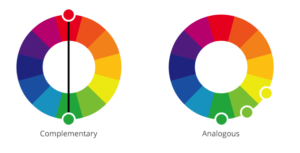

It’s no accident that the colors of fall leaves often mimic the triadic scheme, with one color taking center stage and being flanked by two others. Triadic color schemes are something you’ll see a lot of in nature. You don’t want that type of reaction from someone who looks at your design! You want them to think about how great it looks and for them to remember it! So always remember to use all three equally.

For example: say if you had only used Yellow and Red on your brochure.Then, when people looked at it, they would have thought that it was unbalanced because there was more of one color than another. If you do not use all three equally, then your design will not look harmonious or balanced. By doing this, it would be considered “Using Triadic Colors Equally”. If you were designing a brochure with this concept, you would put the yellow on the cover then put orange on the inside cover and red on the back cover. Let’s say we want to use a triad of yellow, orange, and red. When using triadic colors equally in your design, you need to use each of them once in the same design concept. The primary colors are Red, Blue, and Yellow and the secondary colors are Orange, Green, and Purple. Red and blue are complementary colors (opposite from each other on the color wheel), while yellow is an intermediate color between red and blue.īecause these three colors are evenly spaced around the color wheel, it can create a strong visual impact when used together as opposed. This is because a triad can be thought of as a “color chord” where all three colors relate to each other in tension and harmony.Ī classic example of this is the color combination of red, yellow, and blue. They appear particularly forceful when they are composed of three strong contrasting colors.” In his book, Visual Language: The Structure and Use of Color in Communication, Johannes Itten states, “Tetradic harmonies are more impressive than those based on dyads. While this may seem like a bold statement, it is actually backed by psychological research. Triadic colors have been used in design for centuries, but there are many designers who believe that triadic colors can be used together without looking as “clashing” as non-triadic colors. Triadic colors are colors that are evenly spaced around the color wheel.


 0 kommentar(er)
0 kommentar(er)
